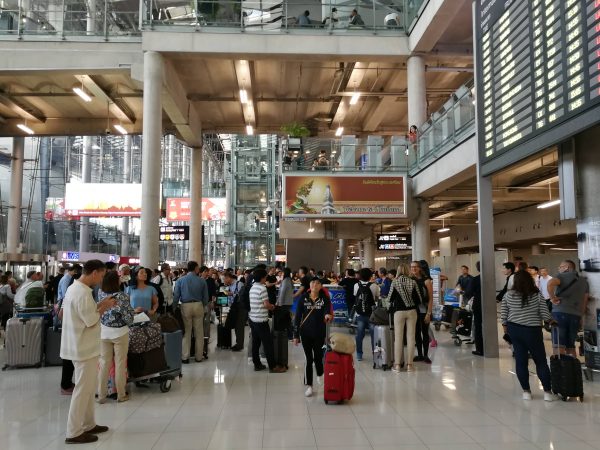BANGKOK, 8 July 2019: Airport passenger movements January to April at Bangkok’s two gateway airports clocked 24,809,157 an increase of 5%.
Airports of Thailand that manages six airports in the country released performance summaries for the first four months of the year.
Domestic passenger movements at the two Bangkok airports (Suvarnabhumi and Don Mueang) totalled 12,579,125 down 1.42% year-on-year.

The count that covers passengers arriving and departing on different flights suggests passenger traffic from the Thai capital to domestic destinations softened during the first four months.
But the 5% increase in international passenger movements indicated international passenger flows remained positive.
Passenger movements do not provide accurate indicators of the state of tourism in the country but they can balance an assessment or indicate if figures sourced elsewhere are flying too high.
However, the latest passenger movements summary confirms Phuket faces a challenge maintaining positive passengers traffic both domestic and international.
The popular holiday island saw international passenger movements at 4,178,141, down 2.37% year-to-date. Adding to the negative outcome, domestic passenger movements at 2,730,477 drifted south by 6.8%.
Together, both international and domestic passenger movements at 6,909,618 were down by 4.17%.
On an island where the hotel construction boom continues and the hospitality business is bemoaning the losses in Chinese tourist arrivals, the negative passenger movements confirms the island has a problem.
It could be blamed on the drop in Chinese tourists to Thailand confirmed in both travel agency and ministry of tourism and sports data, but it could also be attributed to the strengthening of the Thai baht against the US, Australian, European and UK currencies.
Hat Yai International Airport managed by the AOT recorded a massive decline in international passenger movements. It clocked 91,544 but the score was down by 21.86%. Domestic passenger movements reached 1,284,531 down 3.53%.
Chiang Mai and Chiang Rai the two most popular destinations in northern Thailand where the AOT manages airports saw positive growth in international passenger movements although domestic passenger movements flatlined.
Chiang Mai airport totted up 2,915,006 domestic passenger movements but with a zero growth, while northern neighbour Chiang Rai scored 923,028 up slightly by just 1.4%.
Could sluggish domestic passenger movements be attributed to the smog that blanketed both destinations in March and April?
However, international passenger movements to both airports were remarkably robust despite the horrendous agricultural smog blanketing the two destinations during March and April.
Chiang Mai airport reported 1,189,850 international passenger movements up 27.33% all due to the increase in direct flights to neighbouring countries and in China.
A similar positive outlook emerged at Chiang Rai airport with international passenger movements reaching 125,026 and registering a remarkable improvement of 59.68%.
This was largely due to Thai AirAsia launching direct flights from Chiang Rai to Kuala Lumpur, Singapore and Macau, but there were new services from China.
Unfortunately, the boom in international passenger movement could be a flash in the pan for Chiang Rai.
Thai AirAsia cancelled its Kuala Lumpur service last month although it did replace it with direct daily flights to Shenzhen in China.
But there is more bad news for Chiang Rai’s hospitality business still reeling from massive financial losses during the two-month smog crisis in March and April.
The airline is expected to cancel the Singapore and Macau flights in November and may not resume them until April 2020 at the start of the low season and its summer timetable.
In conclusion, the two main airports of North Thailand faired well in passenger movements for January to April due to a boost in international services. That bodes well for the hospitality business if the two cities raise their marketing efforts to reach out markets served by direct flights.
There’s one major question mark looming over the two northern airports; the smog crisis. It is possible the impact of the smog crisis was blunted somewhat because international passengers booked their holiday flights early and were not able to cancel them at short notice, while domestic travellers had that capability. But as international travellers now look forward to what they might book this November through to April next year they are aware of the smog threat that could return for a repeat performance come March 2020. The hospitality industry of both cities should consider this and ask authorities particularly the governors of the two provinces if they have a battle plan?






